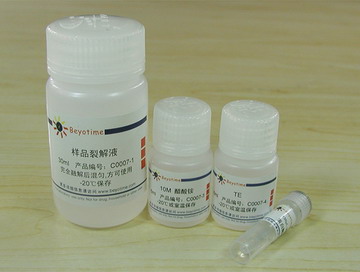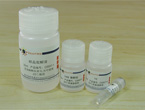|
||||||||||
产品简介
产品简介:
| 产品编号 | 产品名称 | 产品包装 | 产品价格 |
| C0007 | 细胞凋亡-DNA Ladder抽提试剂盒 | 50次 | 193.00元 |
碧云天生产的细胞凋亡-DNA Ladder抽提试剂盒,是针对细胞凋亡过程中产生的核小体间DNA链断裂而设计的。可以非常有效地抽提最小片断为180-200bp的DNA ladder,同时又可以抽提到50kb以上的基因组DNA。
DNA ladder也称DNA fragmentation,是细胞凋亡的一个重要指标。通常观察到DNA ladder,就可以判定细胞发生了凋亡。
本试剂盒足够抽提50个细胞或组织样品。
包装清单:
产品编号 |
产品名称 |
包装 |
C0007-1 |
样品裂解液 |
30ml |
C0007-2 |
蛋白酶K |
130μl |
C0007-3 |
10M 醋酸铵 |
6ml |
C0007-4 |
TE |
6ml |
— |
说明书 |
1份 |
保存条件:
-20℃保存,一年有效。10M 醋酸铵和TE也可以室温保存。
注意事项:
需自备Tris平衡苯酚、氯仿和无水乙醇。
为了您的安全和健康,请穿实验服并戴一次性手套操作。
使用说明
使用说明:
1.样品收集
a)对于组织样品:
切下组织,并剪切成小块,置液氮中冻结,研碎或捣碎。或直接冰浴上匀浆。
b)对于贴壁细胞:
胰酶消化后,PBS或生理盐水洗一次,1000-2000g离心1-2分钟,弃上清,收集细胞。
c)对于悬浮细胞:
1000-2000g离心1-2分钟,弃上清,收集细胞。
2.DNA ladder抽提
a)每1毫升样品裂解液中加入5微升蛋白酶K,混匀。
b)对于上述收集好的样品,每5毫克组织或者106个细胞中加入500微升添加了蛋白酶K的样品裂解液,
Vortex混匀,充分裂解组织或细胞。
c)50℃水浴消化过夜(通常12-20小时皆可)。
d)加入500微升Tris平衡苯酚。
e)Vortex剧烈混匀,使有机相和水相充分混合,以达到抽提效果。4℃,12,000g离心5分钟。
f)缓慢吸出酚相及中间相(可以吸除少量靠近中间相的水相液体),剩余的水相用等体积Tris平衡酚再抽提
一次(同步骤e)。
g)缓慢吸出酚相及中间相(可以吸除少量靠近中间相的水相液体),剩余的水相用等体积氯仿再抽提一次
(同步骤e)。
h)慢慢吸出约300微升上清液,加入60微升10M醋酸铵和600微升无水乙醇,颠倒数次混匀,此时可见DNA沉
淀产生。-20℃冻存1小时,以充分沉淀小片断DNA。冻存过夜或-70℃冻存效果更佳。
i)4℃,12, 000g 离心10分钟,弃上清。
j)加入600微升70%乙醇,轻轻颠倒约2次。4℃,12, 000g 离心10分钟,小心吸去上清。注意:70%乙醇
洗涤的时候,千万注意避免损失一些细小的DNA沉淀,这些沉淀中大部分是你所需的DNA ladder。
k)尽量吸除残余的乙醇,待看不到明显的液体时,立即加入50-100微升TE溶解DNA。注意:不可过分干燥
基因组DNA沉淀,否则会极难溶解。如果发现DNA沉淀难以溶解,可以在4℃用摇床缓慢摇动过夜,以溶
解DNA沉淀。
l)取部分抽提得到的DNA,1%琼脂糖凝胶电泳分析。如果细胞发生凋亡,就可以观察到典型的DNA
ladder。电泳时一定要注意换用新鲜配制的电泳液,DNA凝胶也要用新鲜配制的电泳液配制并新鲜配制
后使用。电泳时为获取最佳的电泳效果使ladder充分分开,电泳速度宜适当慢一些,凝胶宜适当长一
些,而加样孔宜更加扁平一些。选取适当较薄的梳齿,往往会获得更好的ladder电泳效果。
产品图片

相关产品
相关论文
使用本产品的相关论文:
1. Wang N, Hou L, Zhu ZY, Zhang JY, Ju CX, Ge YL, Yue W.
Effect of 2, 3-dioxo indoline on apoptosis and human telomera se
reverse transcr ipta se
mRNA in SH2SY5Y cells.
Chinese Pharm acological B ulletin. 2007 May;23(5):680~4.
2. Qian YF, Wang H, Yao WB, Gao XD.
Aqueous extract of the Chinese medicine, Danggui-Shaoyao-San, inhibits apoptosis in
hydrogen peroxide-induced PC12 cells by preventing cytochrome c release and inactivating
of caspase cascade.
Cell Biol Int. 2008 Feb;32(2):304-11.
3. Bai Y, Li Q, Yang J, Zhou X, Yin X, Zhao D.
p75(NTR) activation of NF-kappaB is involved in PrP106-126-induced apoptosis in mouse
neuroblastoma cells.
Neurosci Res. 2008 Sep;62(1):9-14. Epub 2008 May 23.
4. Cai L, Wang H, Li Q, Qian Y, Yao W.
Salidroside inhibits H2O2-induced apoptosis in PC12 cells by preventing cytochrome c
release and inactivating of caspase cascade.
Acta Biochim Biophys Sin (Shanghai). 2008;40(9):796-802.
5. Wang H, Xu Y, Yan J, Zhao X, Sun X, Zhang Y, Guo J, Zhu C.
Acteoside protects human neuroblastoma SH-SY5Y cells against beta-amyloid-induced cell
injury.
Brain Res. 2009 Aug 4;1283:139-47. Epub 2009 Jun 9.
6. Chai J, Xiong Q, Zhang P, Zheng R, Peng J, Jiang S.
Induction of Ca2+ signal mediated apoptosis and alteration of IP3R1 and SERCA1
expression levels by stress hormone in differentiating C2C12 myoblasts.
Gen Comp Endocrinol. 2010;166(2):241-9. Epub 2009 Aug 31.
7. Li J, Xu Z, Tan M, Su W, Gong XG.
3-(4-(Benzo[d]thiazol-2-yl)-1-phenyl-1H-pyrazol-3-yl) phenyl acetate induced Hep G2 cell
apoptosis through a ROS-mediated pathway.
Chem Biol Interact. 2010 Feb 12;183(3):341-8. Epub 2009 Dec 16.
8. Ou Y, Dong X, Liu XY, Cheng XC, Cheng YN, Yu LG, Guo XL.
Mechanism of tetramethylpyrazine analogue CXC195 inhibition of hydrogen
peroxide-inducedapoptosis in human endothelial cells.
Biol Pharm Bull. 2010;33(3):432-8.
9. Cao H, Feng Q, Xu W, Li X, Kang Z, Ren Y, Du L.
Genipin induced apoptosis associated with activation of the c-Jun NH2-terminal
kinase and p53 protein in HeLa cells.
Biol Pharm Bull. 2010;33(8):1343-8.
10. Li Y, Niu Y, Wu H, Sun Y, Li Q, Kong X, Liu L, Mei Q
Modified apple polysaccharides could induce apoptosis in colorectal cancer cells.
J Food Sci. 2010 Oct;75(8):H224-9.
11.Wang C, Cao J, Qu J, Li Y, Peng B, Gu Y, He Z.
Recombinant vascular basement membrane derived multifunctional peptide blocks
endothelialcell angiogenesis and neovascularization.
J Cell Biochem. 2010 Oct 1;111(2):453-60.
12.Feng Q, Cao HL, Xu W, Li XR, Ren YQ, Du LF.
Apoptosis induced by genipin in human leukemia K562 cells: involvement of c-Jun
N-terminal kinase in G2/M arrest.
Acta Pharmacol Sin. 2011 Apr;32(4):519-27.
13.Wu GS, Lu JJ, Guo JJ, Li YB, Tan W, Dang YY, Zhong ZF, Xu ZT, Chen XP, Wang YT.
Ganoderic acid DM, a natural triterpenoid, induces DNA damage, G1 cell cycle arrest
and apoptosisin human breast cancer cells.
Fitoterapia. 2012 Mar;83(2):408-14.
14.Huang H, Zhao X, Chen Y, Lu R, Wu Y.
Apoptosis induced by ZnPcH1-based photodynamic therapy in Jurkat cells and HEL
cells.
Int J Hematol. 2011 Dec;94(6):539-44.
15.Gao LW, Zhang J, Yang WH, Wang B, Wang JW.
Glaucocalyxin A induces apoptosis in human leukemia HL-60 cells through
mitochondria-mediateddeath pathway.
Toxicol In Vitro. 2011 Feb;25(1):51-63.
16.Chen HB, Zhou LZ, Mei L, Shi XJ, Wang XS, Li QL, Huang L.
Gambogenic acid-induced time- and dose-dependent growth inhibition and apoptosis
involving Aktpathway inactivation in U251 glioblastoma cells.
J Nat Med. 2012 Jan;66(1):62-9. doi: 10.1007/s11418-011-0553-7. Epub 2011 Aug 31.
17.Ye S, Jiang Y, Zhang H, Wang Y, Wu Y, Hou Z, Zhang Q.
Multi-walled carbon nanotubes induce apoptosis in RAW 264.7 cell-derived
osteoclasts throughmitochondria-mediated death pathway.
J Nanosci Nanotechnol. 2012 Mar;12(3):2101-12.
18.Wu G, Qian Z, Guo J, Hu D, Bao J, Xie J, Xu W, Lu J, Chen X, Wang Y
Ganoderma lucidum Extract Induces G1 Cell Cycle Arrest, and Apoptosis in Human
Breast CancerCells.
Am J Chin Med. 2012;40(3):631-42
19.Zhao P, Han T, Guo JJ, Zhu SL, Wang J, Ao F, Jing MZ, She YL, Wu ZH, Ye LB.
HCV NS4B induces apoptosis through the mitochondrial death pathway.
Virus Res. 2012 Apr 19.
20.Tao LL, Cheng YY, Ding D, Mei S, Xu JW, Yu J, Ou-Yang Q, Deng L, Chen Q, Li QQ,
Xu ZD, Liu XP
C/EBP-α ameliorates CCl(4)-induced liver fibrosis in mice through promoting
apoptosis of hepaticstellate cells with little apoptotic effect on hepatocytes in
vitro and in vivo.
Apoptosis. 2012 May;17(5):492-502.
21.Gong K, Xie J, Yi H, Li W.
CS055 (Chidamide/HBI-8000), a novel histone deacetylase inhibitor, induces G1
arrest, ROS-dependent apoptosis and differentiation in human leukaemia cells.
Biochem J. 2012 May 1;443(3):735-46.
22.Shi ZY, Li YQ, Kang YH, Hu GQ, Huang-fu CS, Deng JB, Liu B.
Piperonal ciprofloxacin hydrazone induces growth arrest and apoptosis of
humanhepatocarcinoma SMMC-7721 cells.
Acta Pharmacol Sin. 2012 Feb;33(2):271-8.
23.Jin M, Wang J, Xiao R, Liu X, Wu F, Pang Y, Feng B, Yang D, Li Q.
Effects of the recombinant toxin protein rLj-RGD3 in multidrug-resistant human
breast carcinomacells.
Acta Biochim Biophys Sin (Shanghai). 2012 May;44(5):455-61.
24.Yuan Z, Long C, Junming T, Qihuan L, Youshun Z, Chan Z.
Quercetin-induced apoptosis of HL-60 cells by reducing PI3K/Akt.
Mol Biol Rep. 2012 Jul;39(7):7785-93. doi: 10.1007/s11033-012-1621-0. Epub 2012 May 4.
25.Qiao Y, Xiang Q, Yuan L, Xu L, Liu Z, Liu X.
Herbacetin induces apoptosis in HepG2 cells: Involvements of ROS and PI3K/Akt pathway.
Food Chem Toxicol. 2013 Jan;51:426-33. doi: 10.1016/j.fct.2012.09.036.
Epub 2012 Oct 12.
26.Jiang Y, Zhang H, Wang Y, Chen M, Ye S, Hou Z, Ren L.
Modulation of apoptotic pathways of macrophages by surface-functionalized multi-walled
carbon nanotubes.
PLoS One. 2013 Jun 6;8(6):e65756. doi: 10.1371/journal.pone.0065756. Print 2013.
27.Han L, Tang C, Yin C.
Effect of binding affinity for siRNA on the in vivo antitumor efficacy of polyplexes.
Biomaterials. 2013 Jul;34(21):5317-27. doi: 10.1016/j.biomaterials.2013.03.060.
Epub 2013 Apr 13.
28.Sun JP, Shi ZY, Liu SM, Kang YH, Hu GQ, Huangfu CS, Deng JB, Liu B.
Trimethoxy-benzaldehyde levofloxacin hydrazone inducing the growth arrest and apoptosis
of humanhepatocarcinoma cells.
Cancer Cell Int. 2013 Jul 2;13(1):67. [Epub ahead of print].
29.You P, Xing F, Huo J, Wang B, Di J, Zeng S, Liu J.
In vitro and in vivo evaluation of anisomycin against Ehrlich ascites carcinoma.
Oncol Rep. 2013 Jun;29(6):2227-36. doi: 10.3892/or.2013.2355. Epub 2013 Mar 21.
30.Li R, Cai L, Xie XF, Peng L, Wu TN, Li J.
7,3'-dimethoxy hesperetin inhibits inflammation by inducing synovial apoptosis in rats
with adjuvant-inducedarthritis.
Immunopharmacol Immunotoxicol.2013 Feb;35(1):139-46.doi:10.3109/08923973.2012.
723010. Epub 2012 Sep 17.
31.Jin M, Xiao R, Wang J, Liu X, Liu Y, Xue Z, Lv L, Zheng Y, Li Q.
Low concentrations of the recombinant toxin protein rLj-RGD3 suppress TNF-α-induced
human renal carcinomacell invasion.
Acta Biochim Biophys Sin (Shanghai).2013 May;45(5):377-82.doi:10.1093/abbs/gmt015.
Epub 2013 Feb 21.
32.Song Y, Li X, Li Y, Li N, Shi X, Ding H, Zhang Y, Li X, Liu G, Wang Z.
Non-esterified fatty acids activate the ROS-p38-p53/Nrf2 signaling pathway to induce
bovine hepatocyte apoptosis in vitro.
Apoptosis. 2014 Jun;19(6):984-97. doi: 10.1007/s10495-014-0982-3.
苏ICP备06009238号 |
